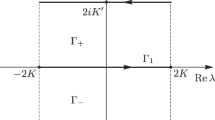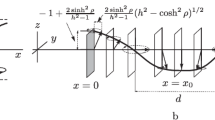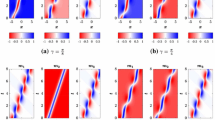Abstract
By the method of dressing on a torus, we obtain and study solutions of the Landau–Lifshitz equation, which describe solitons in the stripe domain structure of the easy-axis ferromagnet. A specific feature of these solitons is that they are directly related to the domain structure: they induce translations and local oscillations of the domains. We find integrals of motion stabilizing the solitons on the background of the structure.
Similar content being viewed by others
References
E. K. Sklyanin, “On complete integrability of the Landau–Lifshitz equation [in Russian],” Preprint No. 79-E-3, LOMI, Leningrad (1979).
A. E. Borovik and V. N. Robuk, “Linear pseudopotentials and conservation laws for the Landau–Lifshits equation describing the nonlinear dynamics of a ferromagnet with uniaxial anisotropy,” Theor. Math. Phys., 46, 242–248 (1981).
A. M. Kosevich, B. A. Ivanov, and A. S. Kovalev, Nonlinear Magnetization Waves: Dynamical and Topological Solitons [in Russian], Naukova Dumka, Kiev (1983).
A. E. Borovik, S. Klama, and S. I. Kulinich, “Integration of the Landau–Lifshitz equation with preferred-axis anisotropy by the method of the inverse scattering problem,” Phys. D, 32, 107–134 (1988).
A. B. Borisov and V. V. Kiselev, Quasi-One-Dimensional Magnetic Solitons [in Russian], Fizmatlit, Moscow (2014).
R. F. Bikbaev, A. I. Bobenko, and A. R. Its, “Landau–Lifstits equation: Theory of exact solutions II [in Russian],” Preprint DonFTI-84-7(82), Donetskii Fiz.-Tekhn. Inst. AN-USSR, Donetsk (1984).
R. F. Bikbaev, A. I. Bobenko, and A. R. Its, “On finite-zone integration of the Landau–Lifshits equation,” Sov. Math. Dokl., 28, 512–516 (1983).
Yu. A. Mitropol’skii, N. N. Bogolyubov Jr., A. K. Prikarpatskii, and V. G. Samoilenko, Integrable Dynamical Systems: Spectral and Differential-Geometric Aspects [in Russian], Naukova Dumka, Kiev (1987).
A. I. Bobenko, “Real algebrogeometric solutions of the Landau–Lifshits equation in Prym theta functions,” Funct. Anal. Appl., 19, 5–17 (1985).
H. Bateman and E. Erdelyi, Higher Transcendental Functions, Vol. 3, McGraw-Hill, New York (1955).
P. F. Byrd and M. D. Friedman, Handbook of Elliptic Integrals for Engineers and Scientists, Springer, Berlin (1971).
V. V. Kiselev and A. A. Raskovalov, “Nonlinear dynamics of a quasi-one-dimensional helical structure,” Theor. Math. Phys., 173, 1565–1586 (2012).
V. V. Kiselev and A. A. Rascovalov, “Nonlinear collective excitations in helical magnetic structures,” Phys. Metals Metallogr., 113, 1114–1126 (2012).
V. V. Kiselev and A. A. Raskovalov, “Solitons and nonlinear waves in the spiral magnetic structures,” Chaos Solitons Fractals, 84, 88–103 (2016).
A. V. Mikhailov, “The Landau–Lifschitz equation and the Riemann boundary problem on a torus,” Phys. Lett., 92, 51–55 (1982).
A. B. Borisov and V. V. Kiselev, “Many-soliton solutions of asymmetric chiral SU(2) and SL(2, R) theories (d = 1),” Theor. Math. Phys., 54, 160–167 (1983).
A. B. Borisov, “The Hilbert problem for matrices and a new class of integrable equations,” Lett. Math. Phys., 7, 195–199 (1983).
N. I. Akhiezer, Elements of the Theory of Elliptic Functions [in Russian], Nauka, Moscow (1970); English transl. (Transl. Math. Monogr., Vol. 79), Amer. Math. Soc., Providence, R. I. (1990).
V. V. Kiselev and A. A. Raskovalov, “Interaction of a breather with a magnetization wave in a ferromagnet with light-axis anisotropy,” Theor. Math. Phys., 163, 479–495 (2010).
V. V. Kiselev and A. A. Raskovalov, “Forced motion of solitary domains and domain walls in the field of a nonlinear magnetization wave,” Phys. Metals Metallogr., 109, 585–598 (2010).
V. V. Kiselev and A. A. Raskovalov, “Forced motion of breathers and domain boundaries against the background of nonlinear magnetization wave,” Chaos Solitons Fractals, 45, 1551–1565 (2012).
V. E. Zakharov, S. V. Manakov, S. P. Novikov and L. P. Pitaevskii, Theory of Solitons: The Inverse Scattering Method [in Russian], Nauka, Moscow (1980); English transl., Plenum, New York (1984).
L. A. Takhtadzhyan and L. D. Faddeev, Hamiltonian Methods in the Theory of Solitons [in Russian], Nauka, Moscow (1986); English transl., Springer, Berlin (2007).
Author information
Authors and Affiliations
Corresponding author
Additional information
This research was performed within the State Assignment of the Federal Agency for Scientific Organizations (Topic “Kvant,” No. 01201463332 (AAAA-A18-118020190095-4)).
Translated from Teoreticheskaya i Matematicheskaya Fizika, Vol. 197, No. 1, pp. 89–107, October, 2018.
Rights and permissions
About this article
Cite this article
Kiselev, V.V., Raskovalov, A.A. Solitons in the Domain Structure of the Ferromagnet. Theor Math Phys 197, 1469–1486 (2018). https://doi.org/10.1134/S0040577918100057
Published:
Issue Date:
DOI: https://doi.org/10.1134/S0040577918100057




